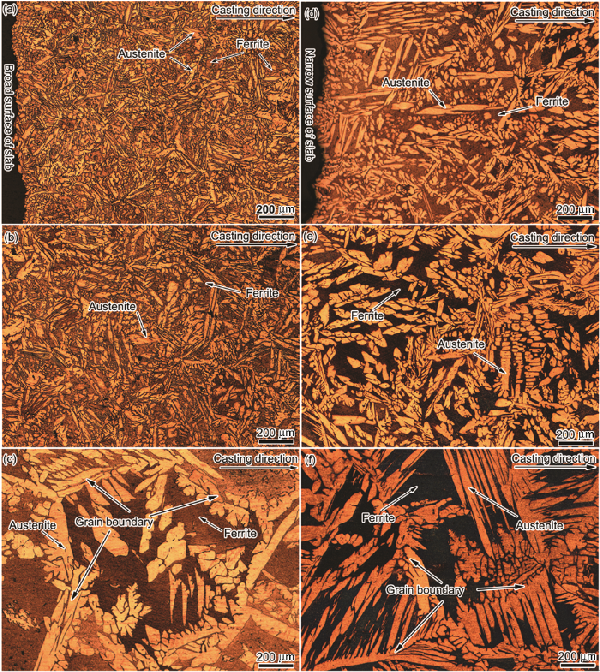
全部
▼
搜索
熱搜:
位置:中冶有色 >
> 2101節(jié)鎳雙相不銹鋼立式連鑄板坯的組織轉(zhuǎn)變
 904
編輯:中冶有色技術(shù)網(wǎng)
來源:白亮,汲琨,劉景順,劉軍,董俊慧,楠頂
904
編輯:中冶有色技術(shù)網(wǎng)
來源:白亮,汲琨,劉景順,劉軍,董俊慧,楠頂

| Location | Mold | Foot roller | No.1 | No.2 | No.3 | No.4 | No.5 | No.6 | No.7 | ||
|---|---|---|---|---|---|---|---|---|---|---|---|
| Length/m | Broad | Narrow | Broad | Narrow | 0.63 | 1.26 | 1.48 | 2.42 | 2.44 | 2.39 | 2.04 |
| 0.7 | 0.7 | 0.3 | 0.7 | ||||||||
| Cooling water/L·m-2·s-1 | 2750 | 250 | 8.39 | 4.63 | 3.16 | 2.0 | 0.95 | 0.64 | 0.39 | 0.29 | 0.16 |
| C | Si | Mn | Cr | Ni | Cu | Mo | B | N | Al |
|---|---|---|---|---|---|---|---|---|---|
| 0.025 | 0.65 | 5.15 | 21.4 | 1.42 | 0.3 | 0.22 | 0.001 | 0.205 | 0.003 |






 分享 0
分享 0
 舉報 0
舉報 0
 收藏 0
收藏 0
 反對 0
反對 0
 點贊 0
點贊 0

 中冶有色技術(shù)平臺
中冶有色技術(shù)平臺 2024年12月27日 ~ 29日
2024年12月27日 ~ 29日  2024年12月27日 ~ 29日
2024年12月27日 ~ 29日  2025年01月03日 ~ 05日
2025年01月03日 ~ 05日  2025年01月03日 ~ 05日
2025年01月03日 ~ 05日  2025年04月27日 ~ 29日
2025年04月27日 ~ 29日 
